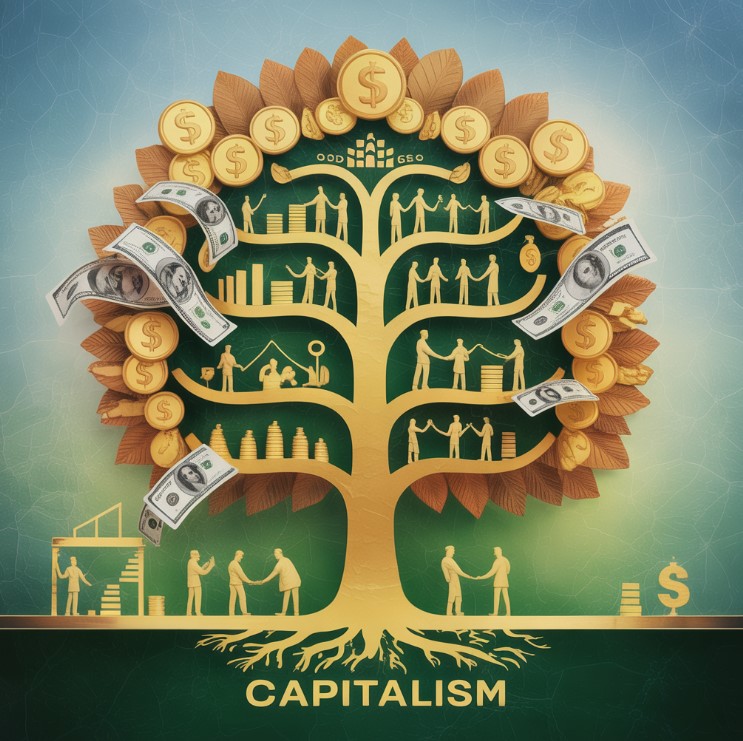Capitalism: What is capitalism, origin, characteristics and examples

Contents
Key points
- The free-enterprise system is characterized by private control over productive assets, using the dynamics of competition and consumer demand to guide the allocation of limited resources.
- In this framework, work is performed for financial compensation, while commercial enterprise is fundamentally driven by the pursuit of profit and the accumulation of wealth.
- Arising in Europe during the 13th century, capitalism gradually supplanted feudalism as the region’s prevailing socioeconomic model. The system’s growth was propelled by colonialism and the philosophical arguments for free markets put forth by figures such as Adam Smith.
- Unlike socialism, capitalism champions the rights of individuals to own property and to freely engage in commerce. Socialism, conversely, is based on the principle that the means of production should be under collective ownership.
What is capitalism?
In a capitalist economy, productive assets such as land, factories, businesses, and capital are under the control of private individuals and firms. Ownership of these resources rests with private entities, not with the government.
The competitive pursuit of profit and wealth accumulation is what governs the market-based allocation of resources.
Capitalism: Simple Explanation
Let’s take a clothing store as an example. Under this model, the store is controlled by an individual or a company, not by the state. Under this model, the store is controlled by an individual or a company, not by the state.
The store’s success hinges on consumer choices, with high sales generating the profits that fuel its growth.A lack of sales, however, will lead to financial losses and potential business failure.
In other words, the capitalist model is one where private citizens and firms possess and direct the means of production. Its operation is based on market competition, where the interplay between supply and demand determines prices.Individuals and firms are thus empowered to make economic decisions in pursuit of the greatest possible profit.
The rivalry inherent in this system is a key driver for both efficiency and innovation. In an effort to win over more customers, companies are constantly driven to improve the goods and services they offer.
As a result, this economic system provides a diverse array of goods and services at competitive prices, driving job creation and allowing for the accumulation of both personal and corporate wealth.
Difference between capitalism and socialism
The defining characteristic of capitalist economies is the market-based production and exchange of goods and services, which is carried out by private companies and individuals. This commerce is conducted through transactions at established prices.
Therefore, economic initiative and decision-making power are vested in individuals, who operate through business and financial enterprises. When it comes to private property, socialism represents the ideological inverse of capitalism. Essentially, it champions the principle that the means of production and goods should be under communal ownership. From this core tenet of defending private property, the other signature traits of capitalism emerge: an emphasis on individual self-interest, a market-based price system, and a competitive environment.
With the passage of time, socialist ideology has shifted from its more orthodox foundations to a more accommodating position regarding free trade.This evolving stance, however, still rests upon the core tenets of governmental oversight in the economic and financial sectors and the protection of the populace from inequality and social abuse.Such blended economies are typically identified as market socialism or social democracy.
Origin and causes of capitalism
Throughout its history, capitalism has been widely characterized as a “free market” or “free economy.”
While commerce and merchants have been fixtures of civilization since antiquity, the economic system of capitalism is a much more recent development, first emerging in Europe during the 13th century. In most of the world, capitalism succeeded feudalism as the dominant economic system.
In the economic systems that preceded capitalism, labor was not a freely chosen pursuit but rather a duty dictated by feudal bonds, slavery, or one’s social responsibility to the community.The system of capitalism is so named because it was founded on the principle of compensating labor with capital, a direct contrast to previous economic models reliant on slavery or serfdom.
History of capitalism
With its roots in the 13th century, capitalist ideology eventually superseded the economic doctrines that had prevailed during the Middle Ages. These concepts were further bolstered by the European colonization of the Americas, a process that began in the 15th century. This development was a direct result of the commerce that arose between the European powers and their colonial territories in the Americas.
A subsequent, pivotal contribution came in the 18th century with Adam Smith’s publication of “The Wealth of Nations.” His work presented a defense of free-market principles. Whether Smith can truly be credited as the founder of capitalism remains a point of contention.
Smith employed the “invisible hand” metaphor to argue that a society would achieve the greatest overall well-being when the government allows the market to regulate itself. This process is governed by the law of supply and demand. Thus, the Scottish philosopher posited that when individuals seek their own personal gain, it paradoxically leads to the optimal outcome for the entire community.
Capitalist thought also drew ideological support from the intellectual and cultural shifts of the Renaissance and the Enlightenment. These movements dismantled the established order of the Ancien Régime, paving the way for the rise of modern states.
The capitalist system would later be challenged by Karl Marx, one of the most defining intellectual figures of the 19th century. He argued that capitalism’s structure inherently leads to the exploitation of the proletariat, the working class, by the capitalists, who own the means of production. This, in turn, gave birth to a current of socialist thought that was taken to its extreme in the 20th century with the communist system of the Union of Soviet Socialist Republics (USSR). However, its proposed model of a completely centralized state economy ultimately failed to yield the desired outcomes.
The fall of the Berlin Wall in 1989 marked a crucial historical turning point, symbolizing the triumph of economic freedom over the communist model. Nonetheless, capitalism was ultimately compelled to accept state intervention in vital sectors such as education and health.
Each significant economic crisis, from the 2008 subprime meltdown to the shutdown caused by the coronavirus pandemic, invariably prompts a re-examination of the capitalist system, leading economists to formulate new policies intended to distribute the free market’s benefits more broadly throughout the population. This is a debate destined to persist, as a universally accepted conclusion on the matter seems unattainable.
Characteristics of capitalism
At its core, capitalism is defined by the following elements:
- A core tenet is the protection of an individual’s right to privately own capital and the means of production.
- This principle ensures the liberty for individuals to both launch and close their own business ventures.
- This refers to a market where prices are set by the interaction of supply and demand, a process that should ideally have little to no government intervention
- This results in a marketplace where individuals can freely choose from a diverse array of products and services. Equilibrium and prices emerge from the collective supply and demand decisions made within this market
Within this framework, the pursuit of self-interest drives economic participants to maximize their profits by accumulating and strategically employing capital. Conversely, those who contribute their labor to the system receive wages or other payments in return, enabling them to purchase the goods and services they require to meet their needs.
How does capitalism work?
In a capitalist framework, the government’s principal duty is to safeguard against market abuses while promoting robust competition.Under capitalism, the state’s essential function is to safeguard the market from exploitative practices and to promote a competitive environment.
Numerous derivative models stem from this core concept, for instance, monopolistic capitalism, financial capitalism, or neo-capitalism. This generated profit is then used to reinvest in the business and to remunerate the employees. Simultaneously, it limits the government’s intervention in day-to-day economic and business matters. This approach, therefore, empowers private entities while assigning the government the role of market oversight.
Advocates for privatizing the means of production contend that private businesses are inherently more efficient managers than state-controlled entities. The burden of bureaucracy and a multitude of duties renders the state inefficient at this task. Furthermore, any losses incurred by a state-run company are ultimately borne by the taxpayers.Conversely, a private firm is solely responsible for its own risk.
Liberals contend that in a competitive market, companies are driven to improve their products and streamline their costs, ultimately offering consumers higher quality at lower prices. A foundational pillar of capitalism and contemporary Western economies is the curtailment of state power and its intervention in the market.
Examples of capitalism
Hallmarks of a capitalist system often include:
- Nowhere was the United States’ identity as the world’s leading capitalist nation more pronounced than during the Cold War, when it stood in stark ideological opposition to the communist Soviet Union.
- A contrasting form of capitalism is practiced in China, where the state has embraced significant economic liberalization while maintaining its single-party political system.
- From a microeconomic standpoint, capitalism is a system where individual firms, rather than the state, have the freedom to determine prices and production levels.
Examples of capitalist countries
The following nations are considered the closest examples of a purely capitalist system:
- Germany
- Australia
- Canada
- United Arab Emirates
- United States
- France
- Japan
- Hong Kong Hong Kong
- Ireland
- New Zealand
- United Kingdom
- Singapore











